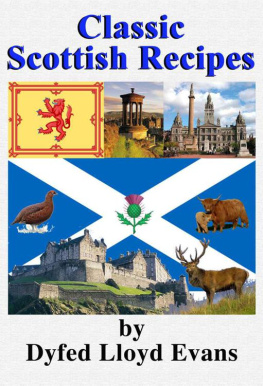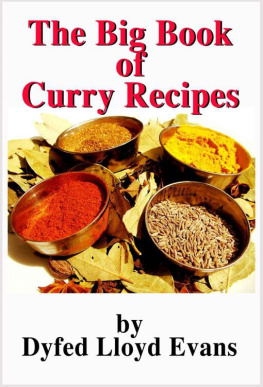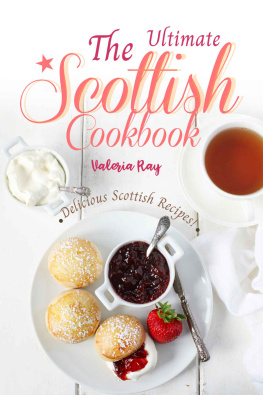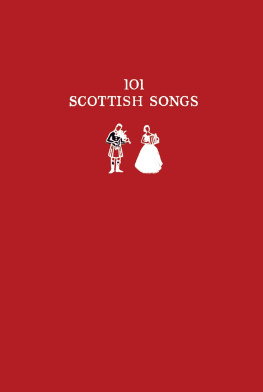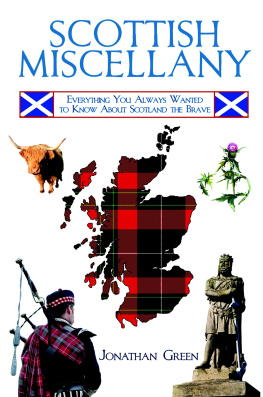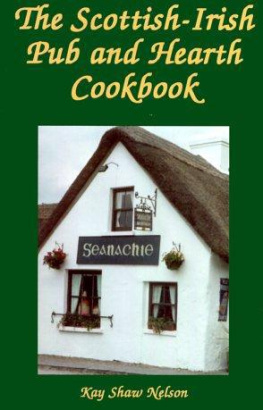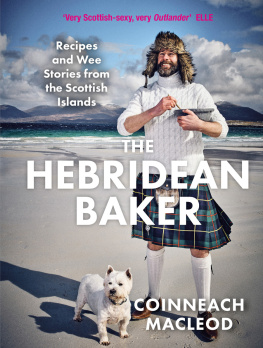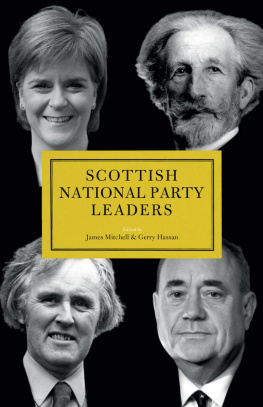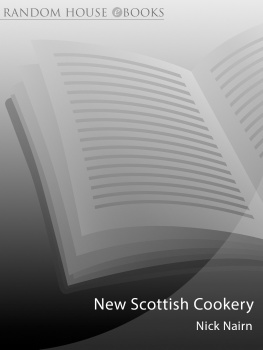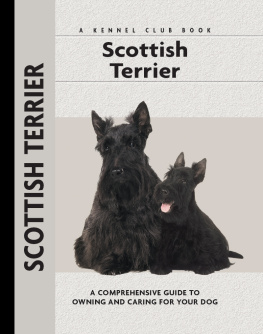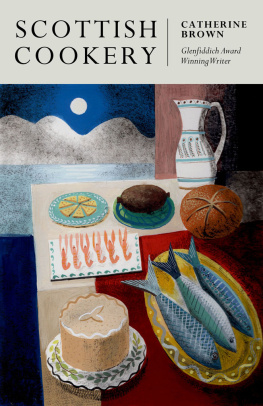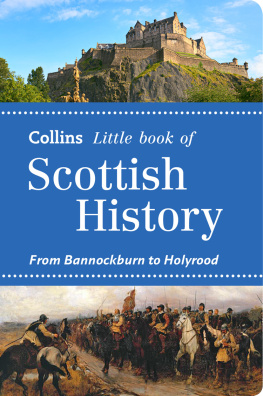
Classic Scottish Recipes
by Dyfed Lloyd Evans Table of Contents.

Introduction. 
Map of Britain, with Scotland in Blue, Ireland in Green, Wales in Red and England in Grey. Scotland is expanded to a larger view, showing the tow main cities (Edinburgh and Glasgow) and all the administrative areas. A Brief History of Scotland
Geographically, Scotland comprises the northernmost third of the island of Great Britain. Scotland is one of the nations that forms the United Kingdom of Great Britain and Northern Ireland (along with England, Wales and Northern Ireland). Scotland shares a border with England to the south and is bounded by the North Sea to the east, the Atlantic Ocean to the north and west, and the North Channel and Irish Sea to the southwest.
In addition, Scotland constitutes over 790 islands, including the Western Isles, Northern Isles and the Hebrides. The border with England runs between the basin of the River Tweed on the east coast and the Solway Firth in the west. This makes Scotlands total area 78,772 km(30,414 sq mi). When Scotland first emerges into recorded history (during Roman times) it was essentially divided between Pictland in the North and the Brythonic (ancestor tongue to Welsh) in the regions of Celyddon (Caledonia), Ystratclud (Strathclyde) and Eiddin (Edinburgh) to the south. With the departure of the Romans from Britain in the fourth century, Irish Gaels invaded Pictland to form the Gaelic speaking Dl Riata whilst Anglo-Saxon invaders pressured the Brython from the South. By the eighth century Scotland was divided between Gaelic speakers and Germanic tribes who spoke a form of Anglo-Saxon that evolved into Lowland Scots dialect.
Indeed, Anglo-Saxon English first evolved in lowland Scotland and not in England! The Kingdom of Scotland emerged as an independent sovereign state in the Early Middle Ages and continued to exist until 1707, although it had been in a personal union with the kingdoms of England and Ireland since James VI of Scotland succeeded to the English and Irish thrones in 1603. Emergence of Scotland as a State
The name Scotland is derived from the Latin term Soti, a word originally applied to the Gaels of Hibernia (Ireland). Accordingly, the Late Latin word Scotia (land of the Gaels) was initially used to refer to Ireland. However, by the 11th century the term Scotia was being used to refer to (Gaelic-speaking) Scotland north of the river Forth, alongside Albania or Albany, both derived from the Gaelic Alba (the modern Welsh for Scotland is still Alban [land of Alba]). It was during the time when Scotland was adopting a distinct political identity (the 10th century) that St Andrew was adopted as the patron saint of Scotland. According to legend, in 832 AD, engus II (the first recognized king of Sotlant) led an army of Picts and Scots into battle against the Angles, led by thelstan, near modern-day Athelstaneford, East Lothian.
The legend states that he was heavily outnumbered and hence whilst engaged in prayer on the eve of battle, engus vowed that if granted victory he would appoint Saint Andrew as the Patron Saint of Scotland. On the morning of battle white clouds forming an X shape in the sky were said to have appeared. engus and his combined force, emboldened by this apparent divine intervention, took to the field and despite being inferior in terms of numbers were victorious. Having interpreted the cloud phenomenon as representing the crux decussata upon which Saint Andrew was crucified, engus honoured his pre-battle pledge and duly appointed Saint Andrew as the Patron Saint of Scotland. The white saltire set against a celestial blue background is said to have been adopted as the design of the flag of Scotland on the basis of this legend. Historically, however, its known that St Andrew had been venerated in Scotland Before this.
The Sottish saltire is the oldest national flag still in use. St Andrews day, 30th November is still celebrated in Scotland and is now a national holiday. War with England and Political Union In the main, the early Scottish state was essentially stable and peaceful, apart from a period in the late 13th and early 14th centuries where a succession dispute allowed the English to make a grab for the Scottish throne. This was only sorted when Robert the Bruce, Earl of Carrick made a claim for the Scottish throne and battled for 20 years to win Scotland back from the Norman English invaders piece by piece. Victory at the Battle of Bannockburn in 1314 proved that the Scots had regained control of their kingdom. Though there was continued war with England through to the 15th century, the Scottish state was not threatened again.
It was in 1502 that James IV of Scotland signed the Treaty of Perpetual Peace with Henry VII of England. He also married Henrys daughter, Margaret Tudor, setting the stage for the Union of the Crowns. For Henry, the marriage into one of Europes most established monarchies gave legitimacy to the new Tudor royal line. It was this marriage that made James IV of Scotland the heir apparent to the English throne upon the death of Elizabeth I. However, it was not until the 1st May 1707 that Scotland entered into an incorporating political union with England to create the united Kingdom of Great Britain. Even today, Scotlands legal system continues to be separate from those of England and Wales and Northern Ireland, and Scotland constitutes a distinct jurisdiction in public and private law.
Modern Scotland In 1999, a devolved legislature, the Scottish Parliament, was reconvened with authority over many areas of home affairs following a successful referendum in 1997. Scotlands capital is the city of Edinburgh and the largest city is Glasgow and the industrial corridor lies on a line joining these two cities.
National Emblems and National Days 
Scotlands national emblems are the saltire of St Andrew, the royal standard of the lion rampant and the thistle as the national flower. Scotlands main national celebrations are Hogmanay (January 1st), Burns Night (25th January) celebrating the birth date of Scotlands national poet, Robert Burns and St Andrews day, November 30th. Scottish Food: Scottish cuisine, like most British cuisine has evolved from peasant cookery and is based heavily on the one grain, oats, that is guaranteed to grow in the damp and cold climate. As much of the agriculture, historically has been based on crofter-style smallholdings, there are many stews based on what a small farmstead could grow (vegetables, greens and chicken pork or mutton in the main). There are also sea fish from the ocean and sea lochs and salmon and trout from the rivers and freshwater lochs.
The national holidays have also meant that traditional foods like haggis, mashed potatoes, oatcakes, porridge and neeps (swedes) remain popular even today. The 18th and 19th centuries brought more baking, particularly in the big cities and that tradition is still evident. Though foraging for mushrooms and wild vegetable and seaweed had almost died out by the 1980s modern chefs are bringing these dishes back to the tables of Edinburgh and Glasgow and there is a resurgence of new cookery in this old nation. About this Book: Though this book is mostly focused on traditional recipes and recipes for Hogmanay and Burns Nigh (there are separate chapters for these) some of the new style cookery is presented there so that you can see the breadth of Scottish cookery. The earliest recipe presented comes form the 1580s and the latest one is from only a couple of years ago. So there is over 500 years of cookery history represented in this volume.
Next page
